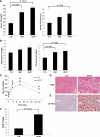Adipocyte apoptosis, a link between obesity, insulin resistance, and hepatic steatosis
- PMID: 19940134
- PMCID: PMC2823448
- DOI: 10.1074/jbc.M109.074252
Adipocyte apoptosis, a link between obesity, insulin resistance, and hepatic steatosis
Abstract
Adipocyte death has been reported in both obese humans and rodents. However, its role in metabolic disorders, including insulin resistance, hepatic steatosis, and inflammation associated with obesity has not been studied. We now show using real-time reverse transcription-PCR arrays that adipose tissue of obese mice display a pro-apoptotic phenotype. Moreover, caspase activation and adipocyte apoptosis were markedly increased in adipose tissue from both mice with diet-induced obesity and obese humans. These changes were associated with activation of both the extrinsic, death receptor-mediated, and intrinsic, mitochondrial-mediated pathways of apoptosis. Genetic inactivation of Bid, a key pro-apoptotic molecule that serves as a link between these two cell death pathways, significantly reduced caspase activation, adipocyte apoptosis, prevented adipose tissue macrophage infiltration, and protected against the development of systemic insulin resistance and hepatic steatosis independent of body weight. These data strongly suggest that adipocyte apoptosis is a key initial event that contributes to macrophage infiltration into adipose tissue, insulin resistance, and hepatic steatosis associated with obesity in both mice and humans. Inhibition of adipocyte apoptosis may be a new therapeutic strategy for the treatment of obesity-associated metabolic complications.
Figures









Similar articles
-
Adipocyte hypertrophy is associated with lysosomal permeability both in vivo and in vitro: role in adipose tissue inflammation.Am J Physiol Endocrinol Metab. 2012 Sep 1;303(5):E597-606. doi: 10.1152/ajpendo.00022.2012. Epub 2012 Jun 26. Am J Physiol Endocrinol Metab. 2012. PMID: 22739104 Free PMC article.
-
Dietary capsaicin reduces obesity-induced insulin resistance and hepatic steatosis in obese mice fed a high-fat diet.Obesity (Silver Spring). 2010 Apr;18(4):780-7. doi: 10.1038/oby.2009.301. Epub 2009 Oct 1. Obesity (Silver Spring). 2010. PMID: 19798065
-
Adipocyte death defines macrophage localization and function in adipose tissue of obese mice and humans.J Lipid Res. 2005 Nov;46(11):2347-55. doi: 10.1194/jlr.M500294-JLR200. Epub 2005 Sep 8. J Lipid Res. 2005. PMID: 16150820
-
Adipocyte-Macrophage Cross-Talk in Obesity.Adv Exp Med Biol. 2017;960:327-343. doi: 10.1007/978-3-319-48382-5_14. Adv Exp Med Biol. 2017. PMID: 28585206 Review.
-
Adipocyte cell death, fatty liver disease and associated metabolic disorders.Dig Dis. 2014;32(5):579-85. doi: 10.1159/000360509. Epub 2014 Jul 14. Dig Dis. 2014. PMID: 25034291 Free PMC article. Review.
Cited by
-
Increased apoptosis and browning of TAK1-deficient adipocytes protects against obesity.JCI Insight. 2016 May 19;1(7):e81175. doi: 10.1172/jci.insight.81175. JCI Insight. 2016. PMID: 27699262 Free PMC article.
-
Association of BID SNPs (rs8190315 and rs2072392) and clinical features of benign prostate hyperplasia in Korean population.J Exerc Rehabil. 2014 Dec 31;10(6):383-8. doi: 10.12965/jer.140168. eCollection 2014 Dec. J Exerc Rehabil. 2014. PMID: 25610824 Free PMC article.
-
Hinokiflavone resists HFD-induced obesity by promoting apoptosis in an IGF2BP2-mediated Bim m6A modification dependent manner.J Biol Chem. 2024 Sep;300(9):107721. doi: 10.1016/j.jbc.2024.107721. Epub 2024 Aug 29. J Biol Chem. 2024. PMID: 39214307 Free PMC article.
-
Activation of invariant natural killer T cells stimulates adipose tissue remodeling via adipocyte death and birth in obesity.Genes Dev. 2019 Dec 1;33(23-24):1657-1672. doi: 10.1101/gad.329557.119. Epub 2019 Nov 14. Genes Dev. 2019. PMID: 31727774 Free PMC article.
-
Developmental origins of nonalcoholic fatty liver disease as a risk factor for exaggerated metabolic and cardiovascular-renal disease.Am J Physiol Endocrinol Metab. 2018 Nov 1;315(5):E795-E814. doi: 10.1152/ajpendo.00394.2017. Epub 2018 Mar 6. Am J Physiol Endocrinol Metab. 2018. PMID: 29509436 Free PMC article. Review.
References
-
- Staels B. (2006) Nat. Med. 12, 54–55 - PubMed
-
- Weiss R., Dziura J., Burgert T. S., Tamborlane W. V., Taksali S. E., Yeckel C. W., Allen K., Lopes M., Savoye M., Morrison J., Sherwin R. S., Caprio S. (2004) N. Engl. J. Med. 350, 2362–2374 - PubMed
-
- Tilg H., Moschen A. R. (2008) Trends Endocrinol. Metab. 19, 371–379 - PubMed
Publication types
MeSH terms
Grants and funding
LinkOut - more resources
Full Text Sources
Other Literature Sources
Medical

